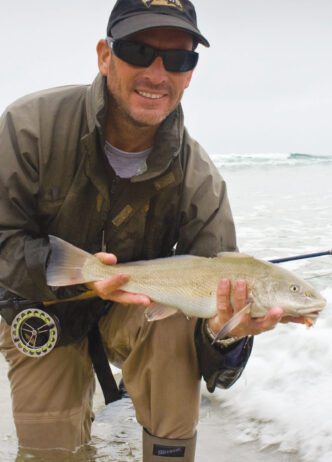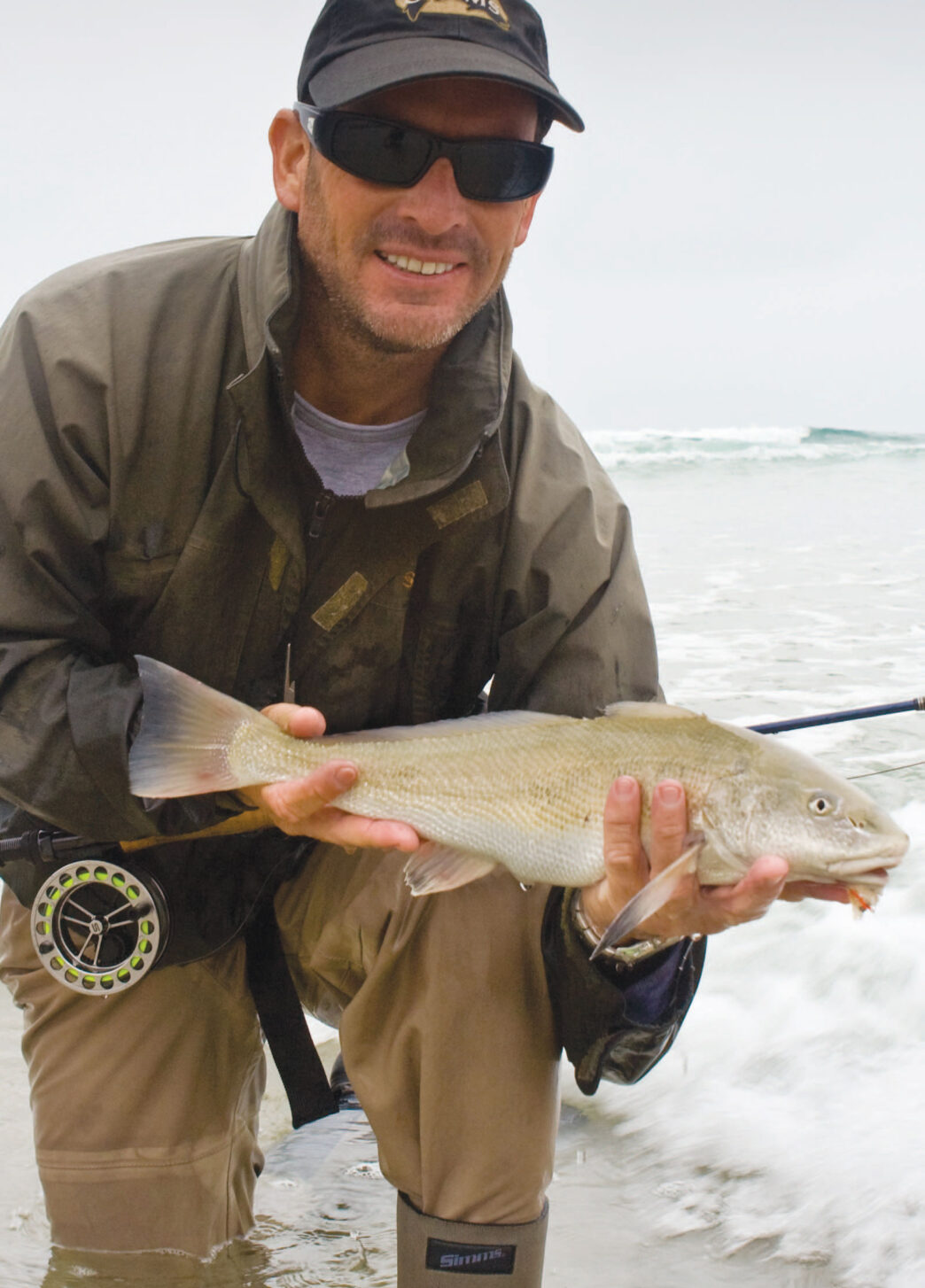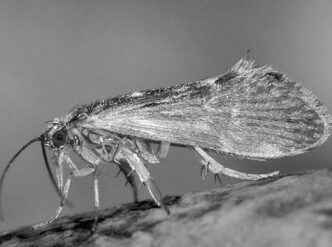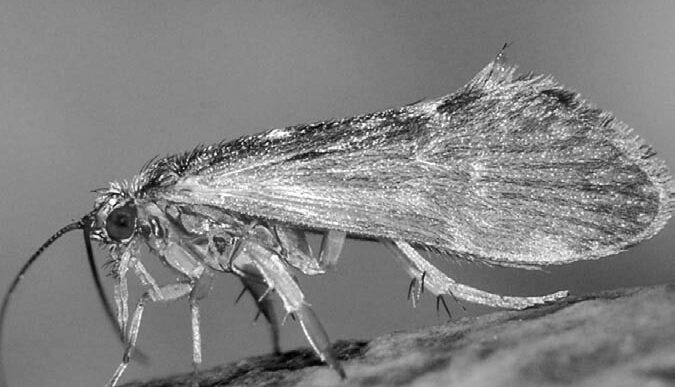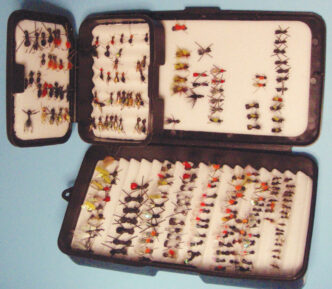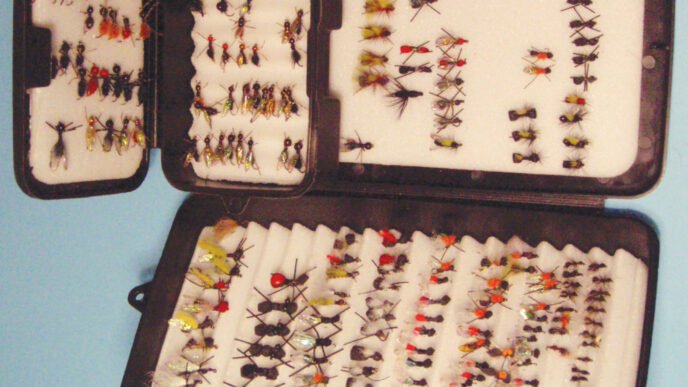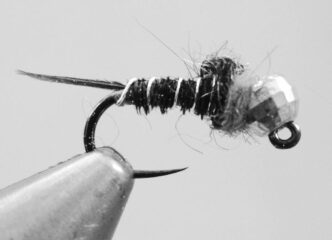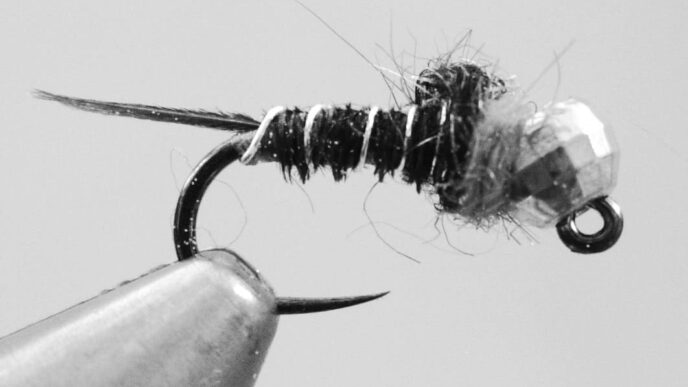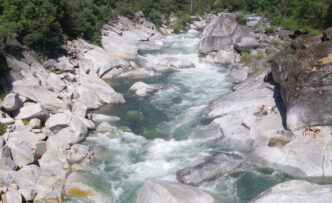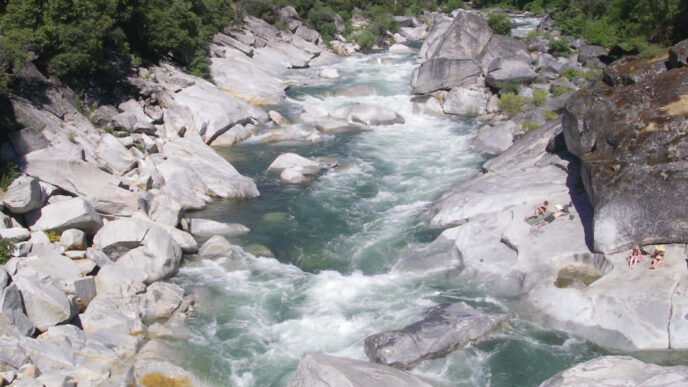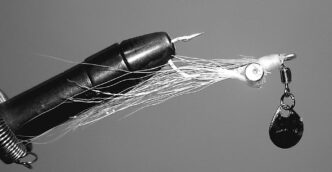Bring up the subject of fly fishing for corbina in a group of surfzone anglers, and you will be amazed how quickly the mood will turn sour. Hide the women and children, because there are likely to be some four-letter words and some phrases that would make even Nick Curcione blush with embarrassment. “Damn fish are so frustrating!” Nick says whenever we discuss corbinas.
Shortly after I moved to San Diego from Colorado in 1994, Curcione introduced me to fishing for the elusive corbina. Having guided trout fishers for several summers on the Frying Pan River, I was used to chasing selective rainbows and browns with small dry flies on light tippets, but I couldn’t imagine the technical requirements, sleepless nights, and lost girlfriends that angling for the corbina would produce over the next 15 years.
The corbina is the West Coast version of a redfish or bonefish and is similar in shape and size. The mouth of this fish sits low on its jaw, which enables the corbina to feed on the sandy bottom with greater ease. A member of the croaker family, and not to be confused with the corvina — an entirely different fish — the corbina can be found as far north as Point Conception and south down the Baja Peninsula.
Find “Happy Fish”
Early in my surf-fishing career, I watched countless bait fishers rig live sand crabs and hook corbina after corbina, all while my fly fishing buddies and I had these fish pass up our artificial flies. I quickly realized that corbinas, unlike bonefish and redfish, rarely feed by sight. Blessed with a barbell shaped protrusion of cartilage on the bottom of its chin that acts as a “feeler,” the corbina is able to root around and hunt for sand crabs and tiny morsels that burrow in the sand. When this fish feels its prey, it simply sucks it into its mouth like a vacuum, then blows the sand out its gills.
Another way the corbina feeds is by smell. Like a dog that can sniff out an old tennis ball hidden somewhere in the yard, these fish use their noses to lead them to their next meal. No wonder we fly fishers love to hate corbinas. Because they’re not visually oriented, they’re tough to catch on a fly.
Fortunately, corbinas at times do feed by sight, and there are two ways you can target them with a fly. One is to simply to cast blindly into likely holding spots such as rips, cuts, holes, and troughs. I’ve caught several corbinas while fishing for surfperch over the years, mostly in the mornings and evenings. They seem to be less spooky and more aggressive in low-light conditions.
The second way you can pursue these fish is to sight cast, which is what I prefer. Although this is by far one of the most challenging experiences I’ve encountered as a fly fisher, it’s also one of the most rewarding. Here are some important factors for success that I’ve learned over the years during countless days pursuing these shallow-water fish.
Having good sunlight is the first ingredient in the sight-casting game, and that’s why I do my corbina fishing between 9:00 A.M. and 4:00 P.M. Spotting these fish can be difficult at first, but over time, you’ll begin to see more fish. The hours before noon are particularly productive for sight casting, because the sun is usually at your back and allows you to see into the water much more easily. Corbinas, like bonefish, blend in with their surroundings. They’re like sand-colored ghosts — one second they are there in front of you, and the next they are gone. Often, you’ll see fish with their backs out of the water as they move into the shallows, searching for crabs, or you might just see their tails out of the water as they suck down their victims. Sometimes when we get the “June Gloom,” a marine layer that frequents Southern California, sight casting gets even more difficult. (Imagine that.) During these times, I have to look for the V wakes the fish leave as they swim around the shallows, searching for food.
It’s not uncommon to see multiple fish in the shallows, feeding together at the same time. More than one fish looking for food seems to create competition, and hook-ups are more common than when you’re fishing for single fish. Any fish that is feeding heavily I refer to as a “happy fish.” These are the fish you’re looking for — they give you the best chance to connect.
As for the best months to fish, although a few corbinas are caught during the winter and early spring, they show up in good numbers in mid to late May and stay until the beginning of October. The fish that are caught during winter and early spring are usually hooked while blind casting to surfperch.
Make the Cast
Your goals should be to limit the number of fish you spook and to get in as many quality casts as you can during each fishing session. Quality casts are not blind casts. Oh sure, you can go ahead and bomb several blind casts in the direction of a spotted fish, but those casts are just Hail Marys — you’ll connect once in a while, but never have the success you could have if you’re patient and wait for a quality presentation.
Last year, I was fishing one of my favorite beaches and spotting a good number of corbinas, only to have them bolt anytime I approached. I couldn’t understand what I was doing wrong. Everything seemed the same as usual. Then I realized I was wearing a bright orange technical fishing shirt that I had received as a gift. I removed the shirt, and it made all the difference. So opt for dull-colored clothing.
Also, leave the waders behind — you won’t need them. In fact, you should wade very little, if at all. I’m constantly moving forward and backward as the wash from the waves comes in and recedes. I kind of play a game and try not to get wet. Corbinas will ride along in this wash to hunt for sand crabs, and if you’re standing ankle or knee deep in the water, the fish will end up right next to you or even behind you — not good, because the fish will spook when they see you. Keep a sharp eye out and remain at the water’s edge. Also, remember to walk softly as you’re moving in and out with the wash. Corbinas can sense the vibrations of your steps through the sand. (By the way, I mostly fish the beaches around San Diego. Beaches to the north can be steeper, with less of a wash. Still, my techniques will work anywhere you can sight cast to these fish.)
When you do spot a fish, relax and don’t panic. Corbinas that are feeding in the wash are careful not to end up on dry land. Your window of opportunity to make a quality cast is limited to between four and seven seconds, that’s all, as the fish searches for food before the next wave hits the beach. You have to limit your false casts to one or two, so as not to startle the fish and in order to give yourself enough time to present your fly. The fish will ride the current back out as the wash recedes. Then is not the time to cast — the fish won’t be able to stop and eat the fly. When the next wash rolls in, be patient. You may not be able to spot the fish right away. This is when you have to fight the urge to cast blindly. It may take several minutes or more to relocate the corbina, but not to worry — it will return.
The cast is the hardest part of corbina fishing. Corbinas are always on the move. Add wave action and multiple currents into the mix, and the result is a tough target to hit. Even for a good fly caster, this can be a very difficult game. Cast too far in front of the fish, and it may feel the leader as you’re trying to bring the fly in front of it. Cast too short, and the corbina will never see your offering. “Line” the fish (cast over its back), and it’s gone. Slap the fly line or the fly on the water, and you’ll startle the fish.
The cast needs to be about two to three feet in front of the fish. After casting, slide the fly toward the fish. Notice that I used the term “slide” instead of “strip.” If you strip the fly, and the corbina thinks the fly is attacking it, it’ll spook. So slide the fly to the fish and then stop. Let the fish find the fly. Keep a tight line by just gently pulling on the line. If the fish eats the fly, you’ll feel the line tighten. Set the hook with a quick strip strike. If you don’t feel the fish, return to sliding the fly — there’s a chance the fish still might eat. Occasionally, the fish will inhale the fly, then, as you’re setting the hook, it’ll drop it before you can connect. That’s just part of the game.
When you do come tight on a fish, start backpedaling in order to clear the line and get the fish on the reel. The corbina will usually make several short runs. Just let the drag on the reel do the work. Do not palm the reel — this can only cause problems. There’s no reason to set the drag light on your reel — you’re not trout fishing. I pay good money for my reels, and I let them do what they’re designed to do — fight fish.
Use the incoming waves to your advantage when battling corbinas. Surf the fish toward the shore, and keep that fish working for its freedom to tire it out. When the waves are receding, don’t fight the current, but keep the pressure on, be patient, and keep a bend in the rod to protect your tippet. When the waves move in toward the beach, pull hard on the fish and repeat the process until you can surf it onto the dry sand.
These fish are priceless, so treat them with respect. Take a few photos, but remember not to keep them out of the water too long. I release all of my corbinas.
Gear
Because the cast and presentation are so critical, I opt for a light fly rod. A 5-weight or 6-weight allows for delicate presentations and is plenty strong enough for fighting these fish quickly and releasing them unharmed.
Fly lines to use off the beach can be debated until the end of time. I always use a fast-sinking shooting head, 200 grains, to be exact. After fishing the surf for over 15 years and after having experimented with multiple fly lines, I’ve found that a sinking line has proved the most effective for me.
With all the hydraulics in the surf pushing, pulling, and dragging on the fly line, a floating fly line just doesn’t allow the fly to stay in the fish’s cone of vision as long as the sinking line. Don’t get me wrong — you can and will catch fish with a floating line and other types of lines, but the sinking line is a proven winner.
My corbina leaders are all hand-tied with fluorocarbon. I like the fact that they’re virtually invisible underwater and extremely abrasion resistant in the harsh surf-zone environment. I start with a 3-foot section of 20-pound test looped to my fly line. Follow that with another 3-foot section of 12-pound attached with a Blood Knot, then another 3-foot section of 8-pound and then a 2-to-4-foot piece of 6-pound tippet.
Reels need to be anodized and easy to clean — sand is brutal on reels. Corbinas don’t make blistering runs, like bonitos, so 100-plus yards of backing will be enough.
Flies
Your guess is as good as mine when it comes to flies, and I have yet to find a magic pattern. But the fly really isn’t all that important — it’s all in the presentation and finding a fish that will feed visually. If the presentation is perfect, there are probably a handful of flies that would work. I do know that smaller flies have been successful for me — sizes 6 and 8. I also know that exact-imitation mole crab or sand crab patterns don’t work any better than flies that only resemble sand crabs. Curcione remembers a time when some conventional-tackle anglers were using an exact plastic replica of a sand crab, complete with the roe sack, and they never caught a fish — “Not even a damn surfperch!” he exclaims. Standard bonefishing and permit flies work well, and I encourage you to get creative at the vise and experiment with some of your own patterns.
There have been some amazing flies that recently have been developed specifically for the Southern California surf, tied by the pioneers, as I like to refer to them, because fly fishing off the beach is still fairly young — guys such as Jeff Priest, Bill Calhoun, Al Q, Shane Chung, Richard Jacobson, Scott Donaghe, Peter Piconi, Aaron Silberberg, Tad Van Allen, Gary Bulla, The Bear, and of course, Ken Hanley and Nick Curcione. Many local fly shops have started offering these flies, and I encourage you to visit and check out what’s hot.
Perseverance
Tidal movement plays a key role in determining the best fishing locations, and each beach has its prime time to fish. It’s important to keep your eye on a tide chart and keep notes of where and when you fish. Here’s an example of what I mean: Beach A with multiple holes and troughs might fish well on a high tide. The higher tide will provide plenty of water to fill in all those holes and allow the fish to feed on prey that is washed into them. At low tide, that same beach won’t have enough water to cover those holes, and therefore the fish won’t be able to get in and feed. Time on the water is the only way to truly gain knowledge of specific beaches and uncover their secrets.
You can catch corbinas by sight casting. Trust me. It takes time, and you’ll get better with each outing. The constant pounding of waves, intense hydraulics, and never-ending erosion continually changes the beach environment. That’s one of the beauties of fly fishing the surf — it keeps you involved in the ever-changing life of the place where the land and ocean meet.



